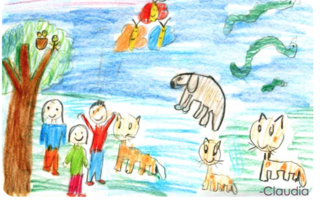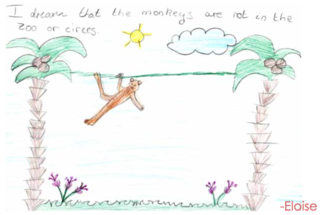Education
Conservation Psychology, Coexistence, Wolves, and Youngsters
A new study shows the importance of dealing directly with controversial issues.
Posted October 27, 2018
"...we need education that helps people see themselves as members of larger ecosystems and communities, indeed as part of a ‘common world’—one where all animals (human and other) have intrinsic value and worth." (Gail Kuhl, 2018)
A new essay by Gail Kuhl called "Sharing a world with wolves: perspectives of educators working in wolf-focussed education" is a very important contribution to the field of conservation psychology. It's not yet available online, so here is a summary of Dr. Kuhl's important findings. I was on her Ph.D. committee and have read the entire essay. While she focuses on wolves, her findings have wide-ranging application for learning how to peacefully coexist with many other nonhuman animals (animals).
Dr. Kuhl interviewed 17 educators from 15 different wolf centers via Skype or telephone, analyzed their websites, and conducted observations at two sites. She concludes, "This research highlights the importance of education as one strategy for wolf conservation, especially if it does not shy away from the messiness of controversial conservation issues and helps people grapple with the social, ethical, regional and cultural aspects of knowing wolves and our relationships as humans with them."
Concerning ethics and conservation, Ms. Kuhl writes, "Most educators felt humans should make adjustments in order to share the landscape with wolves, for instance, explaining how ranchers and farmers might modify their husbandry techniques. Some educators, like Monique, justified the need for these adjustments based on wolves’ intrinsic or inherent worth. She remarked: ‘I mean, who are we to say that any species who’s been extirpated, when that habitat exists, doesn’t have the right to live there, you know?’ In the same vein, some participants expressed concerns about certain conservation management techniques being inhumane. They offered a number of examples, including: an entire wolf pack being destroyed when only one wolf was preying on livestock; the sterilization and re-release of wolves; and a wolf-hunting contest, with awards for capturing the smallest/youngest wolf."
The importance of direct experiences
The importance of direct experiences also emerged. Dr. Kuhl writes, "First, having direct experiences with other animals can lead to understanding their abilities, capabilities, and complexity. For the educators in my study, experiences with actual wolves provided them with a better opportunity to consider ethical questions about wolf conservation. Second, if experiences and relations with wolves can be rich and complex and lead people to seeing them as having agency as happened with the educators in this study, it raises questions about how we humans treat them. As some participants discussed, insights based on direct experience could help inform how conservationists manage wild wolves, a subject inextricably linked with ethical considerations about human-wolf relations."
The importance of direct experiences can also spread into concern for other animals. Along these lines, Dr. Kuhl writes, "Third, some environmental and humane educators propose that the learning that emerges from direct experiences with individual animals as subjects may broaden our ethical scope to take into consideration how we treat other animals more generally in, for example, factory farming, the food industry, and research."
Education improves conservation efforts
Dr. Kuhl also notes, "...all 17 of the participants felt that wolf education is already improving, or can improve, conservation efforts. They suggested that wolf education facilitated, for example, the following: dispelling myths thereby helping people overcome misconceptions and fear of the wolf; creating meaningful experiences that help visitors feel a connection with wolves and nature; and engaging in broader outreach (e.g. to ranchers, farmers, hunters) to implement coexistence strategies (e.g. educating farmers and ranchers about and/or funding non-lethal livestock."
Dr. Kuhl's concluding paragraph nicely summarizes the importance of education and also dealing with difficult issues. She writes, "In order to live well in a world with wolves, we need education and stories that ‘challenge the prevailing Western binaries that separate nature from culture and animals from humans’ (Pacini-Ketchabaw and Nxumalo 2015, 165) because to live successfully in a world with wolves, humans need to engage in decentering exercises that shift our cultural, ethical and pedagogical paradigms. Therefore, we need education that helps people see themselves as members of larger ecosystems and communities, indeed as part of a ‘common world’ (Taylor and Pacini-Ketchabaw 2015; Pacini-Ketchabaw and Nxumalo 2015)—one where all animals (human and other) have intrinsic value and worth." (My emphasis)
I couldn't agree more with Dr. Kuhl's conclusion, and how essential it is that humans of all ages and cultures be humanely educated to foster peaceful coexistence in a diverse and increasingly human-dominated world.
Teach the children well: Humane education gets youngsters and others to connect with other animals with their hearts
"...researchers have found that encounters/experiences with non-human animals can act as ‘pivot points for young people’s affective and creative engagement with the site and emerging issues of environmental responsibility, sustainability’ (Gannon 2017, 9). Fawcett too (2014) discovered that an actual experience with a wild animal was significant; it meant children ‘were much more likely to attribute subjectivity and agency to the animals in their stories’ (67)." (Gail Kuhl, 2018)
Dr. Kuhl's essay reminded me of the importance of educating youngsters for getting them to connect with other animals and nature in general. Most children are inherently and intuitively curious naturalists. They're sponges for knowledge, absorbing, retaining and using new information at astounding rates. We all know this, but often we forget when we're helping to develop their roles as future ambassadors for other animals, nature and ourselves. Some are also future leaders on whose spirit and goodwill many of us will depend. They will be other animals' and our voices, indeed, voices of the universe. So, it makes good sense to teach children well, to be role models, to infuse their education with kindness and compassion so that their decisions are founded on a deeply rooted, automatic reflex-like caring ethic. If we don't, they, we, other animals, human communities, and many different environments will suffer.
I've been fortunate to teach and have mutually beneficial discussions about animals with young students all over the world. We consider such topics as animal behavior, ecology, compassionate conservation and the nature of human-animal interactions (anthrozoology). I'm always astounded by the level of discussion. Classes center on the guiding principles of Jane Goodall's global Roots & Shoots program whose basic tenets are that every individual is important and every individual makes a difference. The program is activity oriented and members partake in projects that have three components: care and concern for animals, human communities, and the places in which we all live together. I work closely with different Roots & Shoots groups around the world.
A wonderful example of the wide-ranging interests of a Colorado Roots & Shoots group can be seen in an essay called "Kids and Animals: Hunting, Zoos, Climate Change, and Hope." The well-being of humans and nonhumans is very important to them. Their dreams center on being safe, taking care of homeless humans, caring for other animals, slowing down climate change and achieving a balanced climate, eliminating war, and working hard so that animals and plants can thrive. They were thankful for family, friends, pets, bikes so they can ride to school and get exercise and cut down on pollution, nature, open space, and clean water.

A book that is available online for free called Kids & Animals: Drawings from the Hands and Hearts of Children & Youth contains numerous examples of what youngsters are capable of producing in terms of artwork and prose. In various Roots & Shoots events held in different countries, they wrote about their dreams and what they are thankful for. Our goal is that this book will inspire other young people to draw and write about their feelings for animals and to put their own ideas into action to care for animals, protect their habitats, and promote compassion, empathy, coexistence, and peace. It is perfect for classes, discussions, and activities focusing on humane education and conservation education so that we all can expand our compassion footprint.

The six chapters in Kids & Animals are titled safety, peace, love, caring, & families, homes & habitats, coexistence & cooperation, and celebration! In each section, there are short phrases and drawings that reflect the general theme, the dreams, hopes, and gratitude of the students, and what they and others can do to realize their dreams by “putting it into action.” The caption for the above drawing by Anisia that was done at a gathering in Barcelona (Spain) reads, " I am thankful for trees, mountains, nature, water, all. I dream a world in harmony humans/nature fill of love." The caption for the other drawing is "I dream that the monkeys are not in the zoo or circus." Youngsters in Israel wrote about their dreams of living in a peaceful world. The book is full of numerous wonderful and inspirational messages, can be downloaded in its entirety, and has been used in classrooms around the world.

The final section of Kids & Animals called Celebration reminds us to notice the wonders of the living world, to play, and to appreciate our opportunities to make the world a better place for all beings, animals and humans alike. Clearly, people working to help animals and humans are not alone; there is a large international community aspiring to these goals. And every individual can make a positive difference by doing simple things. We can look to children and youth for ideas about how we can expand our compassion footprint.
I also am thrilled by the commitment of the teachers I meet. They are very dedicated, and we should all be grateful that such precious and priceless beings are responsible for educating future adults on whom we'll all be dependent.
The bottom line is pretty simple: teach the children well, treat the teachers well, and treasure all. Nurture and provide the seeds of compassion, empathy, and love with all the nutrients they need to develop athe deep respect for, and kinship with, the universe. All people, other animals, human communities, and environments now and in the future, will benefit greatly by developing and maintaining heartfelt compassion that is as reflexive as breathing. Humane education is critical.
It'll be a win-win for every being, nonhuman and human alike, to allow youngsters to express themselves openly and to use what they say to motivate us all to do all we can to save our fragile and tired planet and to be sure that future generations of humans and other animals will be able to thrive.
Compassion begets compassion -- there's no doubt about it.
References
Fawcett, L. 2014. “Kinship Imaginaries: Children’s Stories of Wild Friendships, Fear, and Freedom.” In Routledge Handbook of Human-Animal Studies, edited by G. Marvin and S. McHugh, 259–274. New York, NY: Routledge.
Gannon, S. 2017. “Saving Squawk? Animal and Human Entanglement at the Edge of the Lagoon.” Environmental Education Research 23 (1): 91–110.
Pacini-Ketchabaw, V., and F. Nxumalo. 2015. “Unruly Raccoons and Troubled Educators: Nature/Culture Divides in a Childcare Centre.” Environmental Humanities 7: 151–168. doi:10.1215/22011919-3616380.
Taylor, A., and V. Pacini-Ketchabaw. 2015. “Learning with Children, Ants and Worms in the Anthropocene: Towards a Common World Pedagogy of Multispecies Vulnerability.” Pedagogy, Culture & Society 23 (4): 507–529.




